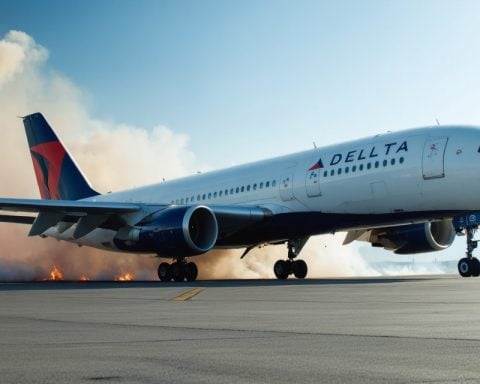As Florida prepares for Hurricane Milton, T-Mobile and SpaceX have secured emergency authorization from the Federal Communications Commission to utilize the Starlink satellite network for urgent communications. This initiative aims to deliver crucial emergency alerts to individuals in areas grappling with disrupted cellular service.
T-Mobile announced plans to provide emergency notifications through this satellite coverage, a move designed to enhance connectivity for residents during natural disasters. The carrier indicated that while this messaging service will be available exclusively to T-Mobile customers, emergency alerts will reach all mobile users within affected regions.
SpaceX shared an update on social media, confirming that standard text message functionality has been activated. This service allows users to send and receive traditional SMS messages directly via their phones’ messaging applications, without relying on internet-based services such as iMessage or WhatsApp.
T-Mobile’s collaboration with SpaceX, initiated in 2022, originally aimed to address connectivity gaps in remote areas. However, it has now proven instrumental in maintaining communication during emergencies. T-Mobile plans to explore expanding this service further to include voice and data capabilities in the future, enhancing overall reliability in crisis situations.
While Apple’s recent satellite messaging solutions have garnered attention, T-Mobile’s satellite service prioritizes customers using their network, ensuring seamless access even when conventional signals are down.
Essential Tips and Life Hacks for Staying Connected During Emergencies
In light of T-Mobile and SpaceX’s recent advancements in emergency communication through the Starlink satellite network, here are some valuable tips, life hacks, and intriguing facts to help you prepare for future emergencies and stay connected when it matters most.
1. Stay Informed with Alerts
Sign up for emergency alert services provided by your local government and mobile carriers. Many states have systems that can send text alerts regarding severe weather conditions, evacuation orders, and other emergencies. This service can ensure you remain aware of critical updates, even when traditional communication channels are disrupted.
2. Download Offline Maps
Before a storm hits, download offline maps on your smartphone. Google Maps and other navigation apps allow you to save maps for offline use, which can be invaluable when cell service is disrupted and you need to navigate safely.
3. Purchase a Power Bank
Keep your devices charged during power outages. A portable power bank can keep your smartphone charged, allowing you to maintain access to emergency services and communication. Consider investing in a solar-powered charger for an added layer of preparation.
4. Keep Important Documents Accessible
Create a digital folder of vital documents, such as insurance policies, identification, and medical records. Use cloud storage services so you can access them from your phone or computer. This can be particularly useful for verifying identity and claims during emergencies.
5. Utilize Satellite Communication
If you’re in an area prone to hurricanes or other natural disasters, consider a satellite phone or a similar device that can connect to satellites instead of relying solely on cell towers. This can provide an additional layer of security should traditional networks fail.
6. Emergency Contact List
Maintain an updated list of emergency contacts, including family members, friends, and local services. Store this list in your phone and keep a printed copy to ensure you can reach out during periods of limited connectivity.
Interesting Fact:
Did you know that the Starlink satellite network, created by SpaceX, is designed to provide global broadband coverage? With thousands of satellites in low Earth orbit, it aims to connect users even in the most remote locations, far from traditional internet infrastructure.
7. Social Media for Updates
Follow local news stations and weather services on social media platforms. They often provide real-time updates during emergencies, and platforms like Twitter can be particularly useful for breaking news and immediate alerts.
8. Plan Your Evacuation
Always have a planned evacuation route and destination in mind. Knowing where to go and how to get there can save valuable time during an emergency, especially if communication methods are compromised.
For more insights on emergency communication strategies and how technology plays a role in disaster preparedness, visit T-Mobile and SpaceX.
By following these tips and leveraging available resources, you can enhance your emergency preparedness and stay connected when it really counts.
The article has been updated: 2024-11-05 08:04
Here are some suggested related links for the post title “Starlink and T-Mobile Team Up for Emergency Communications in Hurricane Milton”:
Starlink – The official website of Starlink, a satellite internet constellation being constructed by SpaceX to provide satellite internet access globally.
T-Mobile – The official site of T-Mobile, one of the largest telecommunications companies in the United States, offering various mobile internet and communication services.
FEMA – The official website of the Federal Emergency Management Agency, which offers information on disaster preparedness, response, and recovery.
National Hurricane Center – The National Hurricane Center’s website provides updates and forecasts on hurricanes and tropical storms, crucial for monitoring severe weather events.
Space.com – A leading source for space news, covering developments in satellite technology, including stories related to SpaceX and Starlink services.
The article has been updated. 2024-11-05 16:58
How are Starlink and T-Mobile collaborating to enhance emergency communications during Hurricane Milton?
Starlink and T-Mobile have partnered to provide vital communications services during Hurricane Milton by leveraging Starlink’s satellite technology. This collaboration allows T-Mobile users to send text messages and make emergency calls even when traditional cellular networks are down. During natural disasters like hurricanes, where ground infrastructure may be compromised, this system ensures that people can stay connected for critical updates and assistance. The initiative aims to improve resilience in emergency response efforts, helping affected individuals communicate with loved ones and emergency services during a crisis.







